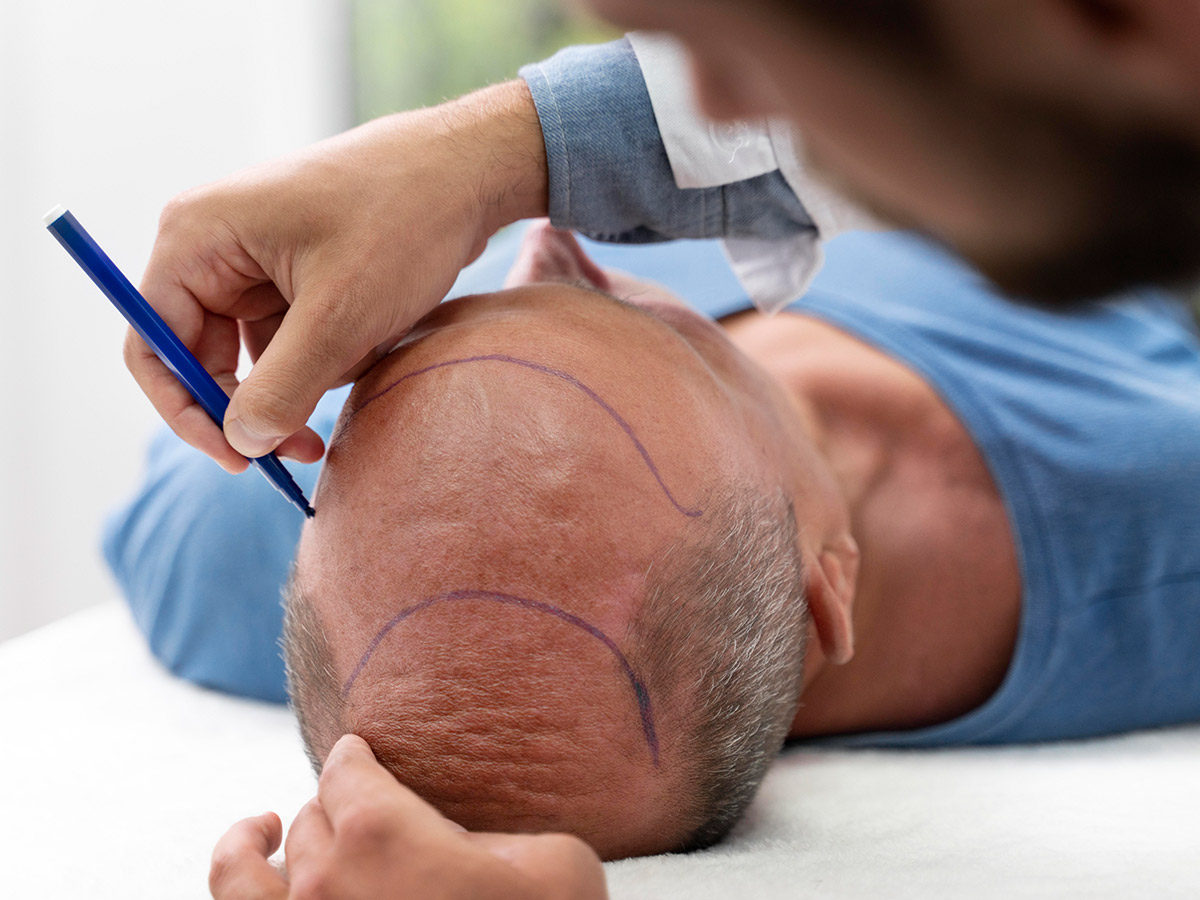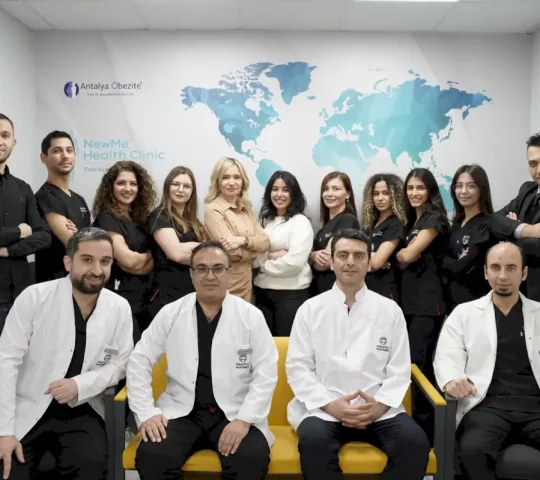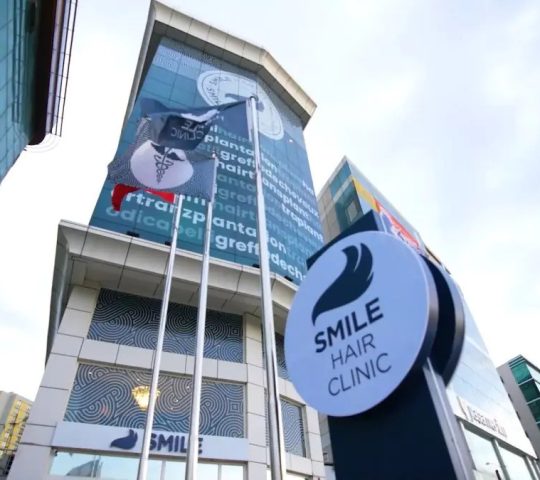This article sheds light on the transformative journey of a hair transplant in Turkey, delving into the nuances of the Norwood Scale and highlighting the efficacy of prescription treatments.
Hair transplants have gained popularity as a solution for severe hair loss, involving the extraction and transplantation of healthy grafts from a donor area. Techniques of hair transplant in Turkey, like Follicular Unit Extraction (FUE) and Direct Hair Implantation (DHI) make up to 5000 grafts feasible.
CatchLife
NewMe Health Clinic
AYT Clinic
Smile Hair Clinic
Dr. Ilker Manavbasi’s Clinic
Health Point World Clinic (former Dr. Soho Clinic)
| Procedure: | FUE/DHI Hair Transplant. Removal & Transplantation of healthy hair follicles from non-bald to bald areas. |
|---|---|
| Procedure Time: | 6-8 Hours per Session |
| In/Outpatient: | Outpatient |
| Anaesthetic: | Local or local & sedation |
| Location: | Specialised Hair Transplant Clinic |
| Possible Side Effects: | Hair thinning, localised swelling, balding, itchiness, infection, scarring, bleeding, death of hair follicles, unnatural look. |
| Recovery Time: | 1-2 Days until you can return home. 10 days for redness. 6-12 moths for full regrowth. |
| Expected Result: | Permanent hair growth in implanted areas. Full regrowth completed in transplant areas after 6 months. |
CatchLife
NewMe Health Clinic
AYT Clinic
Smile Hair Clinic
Dr. Ilker Manavbasi’s Clinic
Health Point World Clinic (former Dr. Soho Clinic)
This is achieved by detailing the following topics:
TABLE OF CONTENTS
The success of transplantation hinges on the health of the donor area, prompting many to wonder: How many grafts do I need? The answer depends on the extent of hair loss and desired density.
The standard recommendation is around 3000 grafts, but special cases, such as wide bald areas or a desire for higher density, may call for 5000 grafts.
Norwood-Hamilton Scale: A Tool for Gauging Androgenetic Alopecia Progression in Men
Critical to this decision is the Norwood Scale, a grading system for hair loss. For hair transplant in Turkey, men at stages 5 and 6 on the scale often find a 5000 graft transplant suitable.
Norwood Hair Loss Scale
The Norwood Scale, or Hamilton-Norwood scale, is a key classification system for male pattern baldness. It offers easy-to-reference images depicting the seven stages of common hair loss patterns. Despite other classifications used by experts, the scale is the go-to reference point for medical professionals and surgeons.
How Does Hair Loss Look on the Norwood Scale?
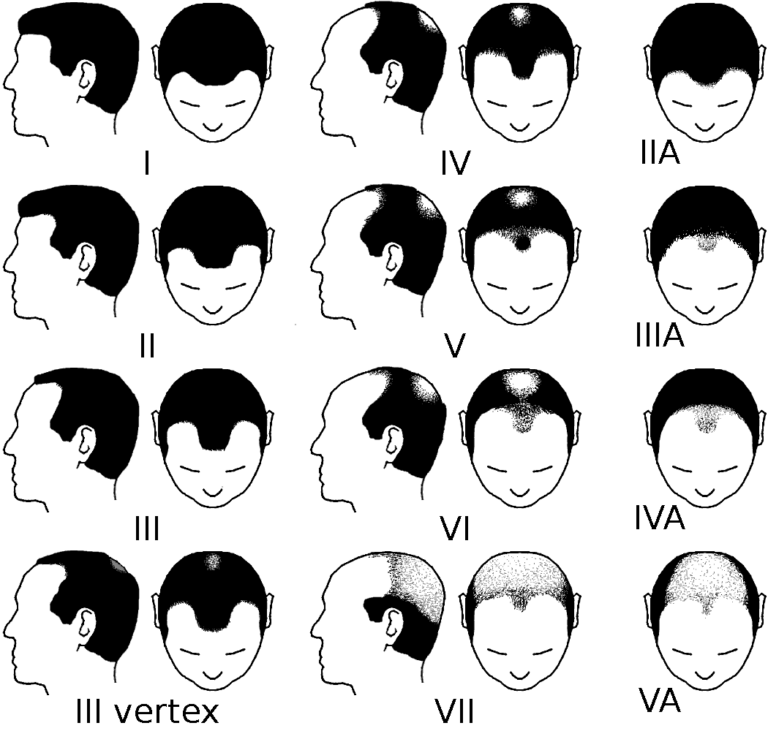
The Norwood Hamilton Scale is a simple format that measures the pattern of hair loss in men. Early stages of hair loss measure a Norwood reading of 1-4. Anything above the measurement of Norwood 4 is seen as advanced stages of hair loss, and therefore more difficult to treat.
For those considering procedures like hair transplant in Turkey, the Norwood Scale serves as a map to assess the extent of male pattern baldness. It not only guides treatment options but also gauges the effectiveness of interventions at each stage. From minimal recession at Stage 1 to extensive balding at Stage 7, the scale provides a comprehensive overview, providing insights into transplant recommendations and potential outcomes.
How Is Male Pattern Baldness Diagnosed?
Diagnosing male pattern baldness before hair transplant in Turkey involves a simple process that comprises a physical examination and a review of medical history. Dermatologists or baldness specialists evaluate the pattern and extent of loss during this examination.

Additionally, they may gently tug at a few hairs and examine the follicles to gauge the condition and progression of male pattern baldness. This assessment helps classify the severity of the recession using recognized scales and envision the hair transplant Turkey before and after.
How Is Hair Loss Treated?
Addressing baldness is most successful when initiated early. Surgeons doing hair transplant in Turkey know that it’s generally easier to slow down loss than to stimulate new hair growth, as dormant follicles, inactive for about two years, can’t be reactivated.
For individuals with significant baldness, surgical procedures may emerge as the most effective option. Recognizing that loss is a prevalent issue, doctors and researchers are continually exploring treatments for male pattern baldness. Available interventions range from medications and Platelet-Rich Plasma (PRP) therapy to more advanced solutions like hair transplant in Turkey.
Hair Transplant: Methods
While various transplant methods exist, the two most commonly employed techniques for hair transplant in Turkey are Follicular Unit Extraction (FUE) and Direct Hair Implantation (DHI). Ideal for addressing permanent hair loss, transplantation provides a long-lasting and natural solution.
Typically performed under local anesthesia, the surgical procedure is followed by a recovery period lasting a few weeks. The complete results of a hair transplant in Turkey become evident after 9-12 months post-surgery. This timeframe allows for the growth and integration of transplanted hair, providing a comprehensive and enduring solution.
How Many Hair Grafts Do I Need?
The number of grafts needed for a hair transplant in Turkey is contingent upon various factors. Diagrams depicting the average graft requirements serve as visual aids, illustrating the recommendations based on the severity of baldness.
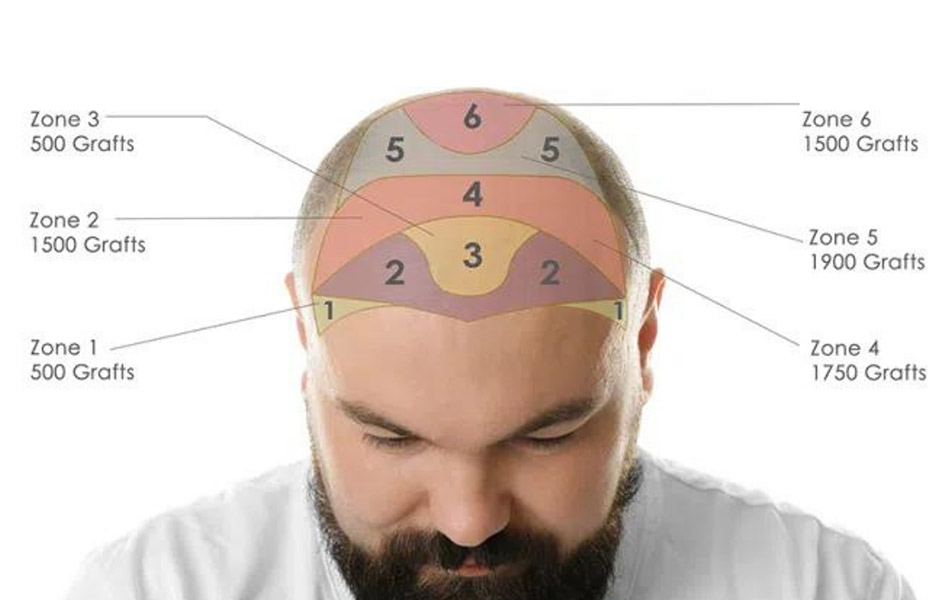
Guidelines typically suggest 600+ grafts in the case of minimal loss to 3000 or beyond for advanced cases. The actual number hinges on factors such as the thickness of the hair, the size of the area affected, and the specific stage identified on the Norwood Scale.
Consulting the scale aids in precisely determining the stage of hair loss, providing a crucial reference point to establish the most effective and tailored approach to meet individual needs for hair transplant in Turkey.
Stage 1 | 0 – 1000 Grafts
During Stage 1, there is minimal to no significant hair loss or recession of the hairline. While individuals in this stage may experience slight recession at the temples, it is generally considered a phase of minimal loss. Recommendations during hair transplant in Turkey often include exploring medications as an initial alternative to surgery. However, for suitable cases, a minor transplantation procedure could be an option to address early signs of recession and preserve a natural appearance.
Stage 2 | 1000 – 1500 Grafts
At Stage 2, men may exhibit slight recession around the temples, marking the initial signs of male pattern baldness. This stage is often associated with the transition from a juvenile to an adult or mature hairline.
For those in Stage 2, a combination of a 1000 grafts hair transplant and baldness medication can yield excellent results. It may vary individually, but typically, at Stage Two, 1000 to 1500 grafts are recommended to achieve the desired hairline. To maintain density, individuals may opt for topical or oral medications or engage in regular PRP (Platelet-Rich Plasma) treatment sessions. These interventions are often part of hair transplant in Turkey contributing to both the preservation of existing and the promotion of new hair growth.
Stage 3 | 2000 Grafts
In Stage 3, men commonly begin expressing concerns about their appearance. Depending on genetic factors, this stage may manifest as a V, M, or U-shaped hairline. Characterized by moderate baldness, individuals may experience a receding hairline and overall thinning of the crown. The areas of recession are either entirely bald or sparsely covered.
Given the nature of this stage, a hair transplant in Turkey becomes a more viable solution, as medications alone may not suffice. The recommendation often involves around 2000 grafts to achieve a dense and natural hairline. Complementary interventions such as PRP and medications continue to play a beneficial role in maintaining density, contributing to the overall success of transplantation procedures.
Stage 3 – Vertex | 2000 – 2500 Grafts
In Stage 3 – Vertex, the hairline maintains an appearance close to Stage 2, but there’s notable loss on the top of the head, specifically at the vertex. This stage is characterized by moderate to severe recession and is successfully treated during hair transplant in Turkey.
For men in Stage 3 – Vertex, the recommended solution involves allocating 1000 – 1500 grafts for the hairline and an additional 500 – 1000 grafts for the crown area. This results in an overall recommendation of 2000 – 2500 grafts to address both regions comprehensively.
Combining medications and PRP treatments with hair transplant in Turkey proves beneficial. This integrated approach offers a comprehensive strategy for protecting existing hair and providing support for the success of the transplant.
Stage 4 | 3000 – 3500 Grafts
At Stage 4, hairline recession becomes more severe, often accompanied by sparse or no hair on the vertex. The characteristic feature is two bald areas separated by a band of hair connecting to the remaining hair on the sides.
For individuals in Stage 4 with extensive baldness in both the temples and crown, a hair transplant in Turkey procedure typically involves 3000 – 3500 grafts. The pattern of baldness may result in a deeper U shape if there’s no significant loss at the top.
A minimum of 3000 grafts is generally recommended, and if the loss is stabilized, up to 4000 grafts may be suggested to achieve a dense look. Ongoing medication and PRP treatment play a crucial role in supporting and fostering the results of the transplant. This combined approach of hair transplant in Turkey addresses both the immediate concerns of recession and works towards long-term hair preservation.
Stage 5 | 3500 – 4500 Grafts
In Stage 5, the loss progresses rapidly and severely, manifesting in larger bald areas and a thinner connecting band. Existing hair becomes sparser, and without a band, the hairline may further recede. With this condition, a hair transplant in Turkey may be a viable solution.
Individuals in Stage 5 are often advised a minimum of 3500 grafts to establish a robust front line. For comprehensive coverage, the recommendation increases to approximately 4000 grafts. If the donor area demonstrates health and strength, a translocation of up to 5000 grafts in a procedure of hair transplant in Turkey becomes a useful consideration.
Ensuring the sustained success of the transplant, ongoing medication, and PRP treatments form integral aspects of the comprehensive strategy tailored for Stage 5 recession challenges.
Stage 6 | 4500 – 6000 Grafts
Stage 6 loss is characterized by a complete merge of the receding hairline and the crown. This condition demands a comprehensive approach. As part of the hair transplant in Turkey, the surgeon will carefully assess the donor area and determine the optimal graft count, considering a minimum of 4500 grafts and potentially up to 6000 grafts in two sessions.
To achieve a natural-looking hairline, patients considering hair transplant in Turkey may want to consider raising it slightly to enhance density. Continued treatment with medication and PRP injections can maximize the success of the transplant by ensuring the health and vitality of the transplanted follicles, leading to long-term growth.
If you’re curious about the 5000 grafts hair transplant cost Turkey, note that prices can vary based on factors like clinic reputation, surgeon expertise, and additional services. Consultation is advised to discuss graft count and any specific preferences.
Stage 7 | 7000+ Grafts
Stage 7 represents the most severe form of baldness, characterized by a band of hair encircling the head. The density is low, and weak strands are typically present around the sides, while the top is completely bald.
Achieving full coverage in Stage 7 through procedures of hair transplant in Turkey requires a minimum of 7000 grafts. However, it’s crucial to note that more than 6000 grafts in a single session may not be advisable for all individuals. If eligible, the recommended approach is to undergo 7000 grafts in two sessions.
Alternatively, a viable option is to have the initial 6000 grafts in two sessions, followed by a second operation one year later. This staged approach to hair transplant in Turkey ensures a more measured and effective strategy for addressing the complexities of Stage 7 loss.
How Many Hair Grafts Does the Average Person Have for a Hair Transplant?
Inquiring about how many grafts hair transplant typically involves, the average individual often falls within the range of 1000 – 2000 grafts. While more extensive cases may necessitate additional grafts, the requirement for 5000 or 6000 grafts in a single procedure is not frequent.
The donor area’s constraints are deemed optimal between 4000 and 6000 grafts. Overharvesting carries cosmetic risks, and excessive implantation of follicles may lead to insufficient blood supply, compromising their survival. For those considering a hair transplant in Turkey, it is wise to follow the guidance of the surgeons. Potential future treatment may be needed to address the ongoing recession and manage the progression of male pattern baldness.
While a rapid 5000 grafts relocation is feasible, it’s crucial to acknowledge the complexity of a single-session operation, reserved by experienced surgeons for special circumstances. Inquire about the 5000 grafts hair transplant cost Turkey, where all-inclusive prices, ranging from $2,000 to $4,000, often cover accommodation, transportation, translation, and various medical services, making it an appealing destination for such procedures.
Over-the-counter (OTC) Treatments
Over-the-counter (OTC) treatments offer convenience without invasive operations or surgery, though their efficiency is debatable.
- Minoxidil: Applied directly to the scalp, this topical treatment, found in foam or shampoo, seeks to counteract thinning and promote growth. It may require over six months to exhibit its complete effects by reducing DHT levels on the scalp. DHT is a hormone linked to baldness, and managing its levels is crucial for effective treatment. Incorporating such treatments alongside a hair transplant in Turkey can be a comprehensive strategy for addressing recession concerns.
- Laser Devices: Devices such as brushes and combs with laser light are available, claiming to stimulate hair growth, although clinical evidence supporting this claim is not established.
Prescription Treatments
In addressing the severity of baldness, experts in hair transplant in Turkey may prescribe treatments with the drug finasteride (Proscar, Propecia). This FDA-approved medication, endorsed by the American Academy of Dermatology, is reported to slow recession in around 88 percent of men and stimulate regrowth in approximately 66 percent.
Combining finasteride with a hair transplant in Turkey can be an effective strategy. Finasteride, an oral drug taken daily, helps reduce fallout. However, users should be aware of potential side effects, and caution is advised for pregnant women to avoid handling crushed or broken tablets.
Procedures
Medical interventions for fallout include:
-
- Platelet-Rich Plasma (PRP) Treatment: A non-surgical process utilizing the patient’s own blood plasma, rich in growth factors, injected into the scalp to trigger natural growth.
- Hair Transplantation: Surgically relocating follicles from areas with good growth to balding areas.
- Scalp Reduction: Surgical removal of some bald scalps, bringing areas with good growth closer together, often combined with transplantation.
- Scalp Expansion: Devices placed under the scalp stretch the skin, performed as a stand-alone procedure or prior to the scalp reduction.
- Micropigmentation: Applying tiny tattoos to simulate the look of a shaved head.
The Takeaways
- Understanding the Norwood Scale provides a pivotal guide for baldness treatment, including hair transplant in Turkey. The scale aids in determining the number of grafts needed for effective treatment. Surgical and non-surgical procedures offer diverse approaches.
- It’s essential to consult with qualified professionals, considering individual circumstances, the Norwood stage, and desired outcomes.
- Combining treatments, such as prescription medications, can enhance overall success, providing a comprehensive strategy for addressing baldness concerns.
CatchLife
NewMe Health Clinic
AYT Clinic
Smile Hair Clinic
Dr. Ilker Manavbasi’s Clinic
Health Point World Clinic (former Dr. Soho Clinic)
- Guarrera, M., et al. “Reliability of hamilton-norwood classification.” International journal of trichology 1.2 (2009): 120.
- Ogata T. Development of patterned alopecia. Sogo Rinsho. 1953;2:101–6.
- Bouhanna P, Dardour JC. Male baldness: Dynamic classification of Dardour and Bouhanna. In: Bouhanna P, Dardour JC, editors.
- Hair Replacement Surgery. Berlin: Springer-Verlag; 1996. pp. 33–4.
- Bouhanna P. Multifactorial classification of male and female androgenetic alopecia. Dermatol Surg. 2000;26:555–61.
- Hong H, Ji JH, Lee Y, Kang H, Choi GS, Lee WS. Reliability of the pattern hair loss classifications: A comparison of the basic and specific and Norwood-Hamilton classifications. J Dermatol. 2013;40:102–6
FAQ
The Hamilton-Norwood scale is a visual tool used to identify different degrees of male pattern baldness, numbered from 1 to 7. Doctors and hair restoration specialists often use the Hamilton-Norwood scale to assess baldness, though its reliability is questionable due to differing conclusions.
A mature male’s normal hairline starts between 2.4 and 3.2 inches above the eyebrows, and has a clear U-shape. Men may also have a natural widow’s peak, though that’s fairly uncommon.
- Type I has minimal or no hairline recession.
- With Type II, recession occurs at the frontotemporal areas of the hairline, typically in symmetrical patterns.
- Type III is the minimal level of hair loss to be recognised as baldness on the Hamilton-Norwood scale.
Norwood 2 hairline may be caused by a maturing hairline, but it could indicate that further hair loss and thinning will occur in the future. However, patients can take steps to prevent additional hair loss and reverse it, even lowering the hairline to its original position.
The availability of grafts for transplant is primarily determined by the genetically coded permanence of donor area grafts. On average, individuals have 4,000 to 6,000 grafts, but this varies. Extracting too many grafts poses a cosmetic risk.
The actual number needed depends on factors like loss extent and desired density. A successful hair transplant in Turkey often involves 2,000 to 5,000 grafts.
Consulting with a qualified professional is essential to determine specific requirements.

